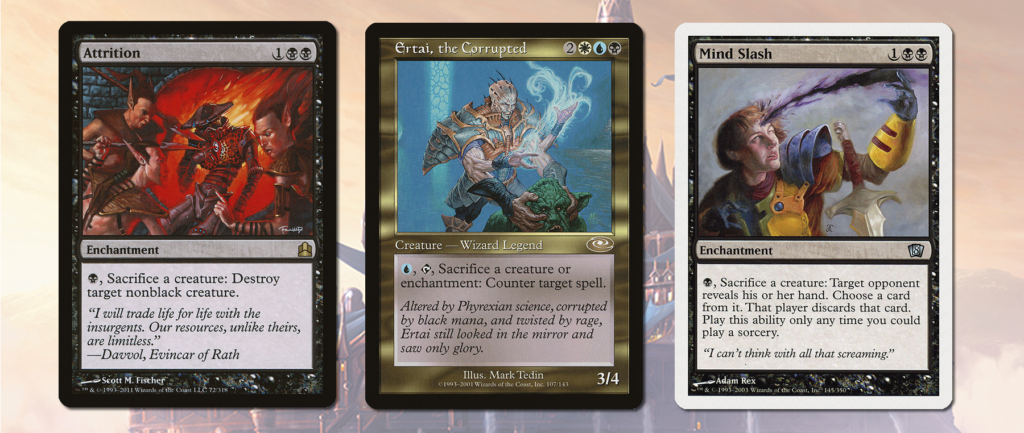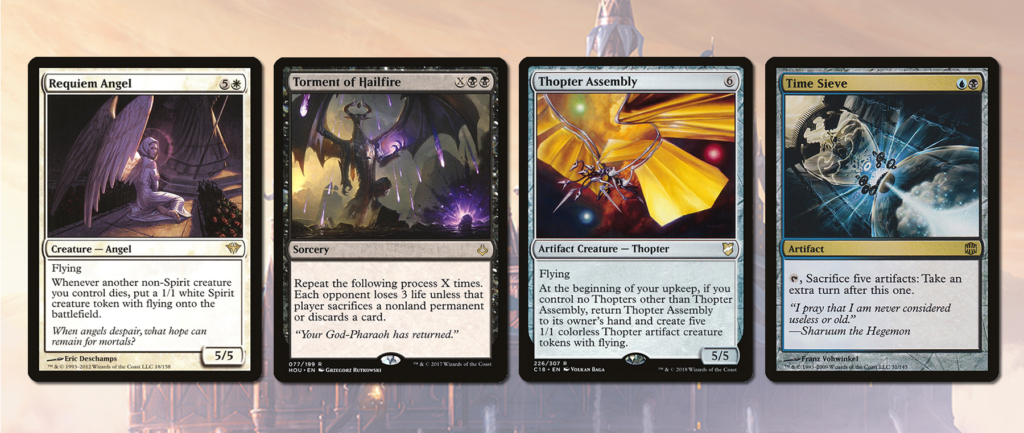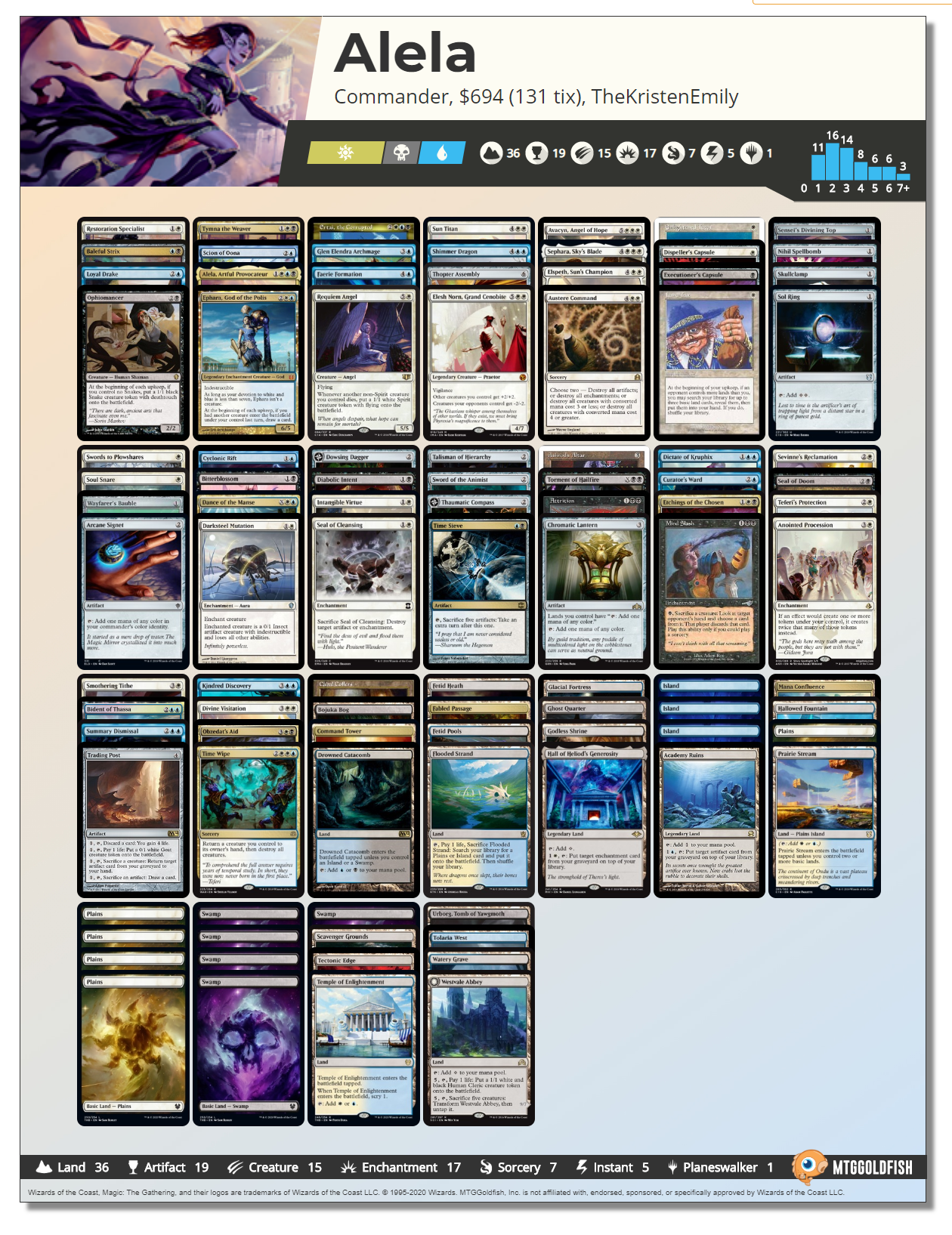This week on Legion’s Landing, Kristen revisits the idea of uniqueness in Commander decks with Part 2 of her series on conserving design space. This week, she looks at her build of Alela, Artful Provocateur. If you haven’t had a chance yet, you can read Part 1 here, and a related article on keeping gameplay fresh here.
Last time we sat down to look at this topic, I went over my Elsha of the Infinite Commander deck. It’s a deck I love to bits, and a deck that brings a unique kind of gameplay to the table—that of many routes to a more linear win condition. The challenge last time around was making sure the deck didn’t tread on the feet of two decks I was planning to build in the future: Kykar, Wind’s Fury and Alela, Artful Provocateur.
Conserving Design Space
Fresh from building Elsha, I sat down to take a swing at Alela with three main objectives in mind: to avoid delving too deeply into artifacts; to avoid dipping too deeply into any signature Kykar spells, like Monastery Mentor; and to edge away a little from going too far down the pure aggro route. This last one was because I’d been eyeing up Shared Animosity for Kykar, and I didn’t want the decks to feel too similar and end up both just spamming flying tokens to later buff them for damage.
Additionally, as I’d used the Sensei’s Divining Top “Storm” strategy in Elsha, I decided to forgo trying to go infinite with it in this deck—even though it is definitely a viable way to build the deck. It would be easier to diverge from this by focusing more on enchantments, anyway. With those restrictions in mind, I set about to build.
As I put the deck together, I noticed that I naturally diverged from a full Enchantress style deck. It wasn’t speaking to me, and slowly, certain cards started to creep in. Including cards like Sun Titan and Sevinne’s Reclamation made cards like Nihil Spellbomb, Dispeller’s Capsule and Executioner’s Capsule attractive prospects, for example; they were cheap cards that made tokens with Alela, that could be later recurred and replayed for value.
A lot of the payoffs I’d selected were bigger than Sun Titan could return, though, so some additional recursion was needed. Beyond Obzedat’s Aid, a multipurpose all-star for Orzhov, I selected Restoration Specialist. A new pet card for me, the dwarf artificer works best with artifacts too, so including more artifacts made sense in order to get the full value from playing such a card.
Sacrificing some of the artifact payoffs to include enchantments was fine to me, as I wasn’t building the deck to excel in the most cutthroat of metas; similarly, not going full enchantress wasn’t a burden either, as most of the good payoffs for this strategy involve Green anyways. Above all else, I wanted to create a memorable and enjoyable experience piloting the deck.
How Does it Play?
The deck has aimed for a controlling shell that allows it to pick and choose engagements while putting pressure on through chip damage. The main aim of the game is to play out Alela and keep her on the board, generating value with tokens as you play the game. You’ll be able to get in for damage early to mid game, utilizing cards like Tymna, the Weaver and Bident of Thassa to draw more cards, and adding up the damage with cards like Intangible Virtue and Scion of Oona. Scion is a great card, keeping our Commander from being targeted with removal. Tthough we aren’t full Faerie tribal, it’s definitely worth running in most if not all builds.
As we’re invested in having Alela in play, Loyal Drake is another excellent form of card draw that enjoys the buff Alela deals out. Between Land Tax, Sword of the Animist, Dowsing Dagger, Skullclamp, and Dictate of Kruphix, we should be able to hit our land drops and keep drawing into our stronger plays. Kindred Discovery keeps us topped up as the game continues.
Setting up traps is another great way to spend mana early game. Between Seal of Doom, Executioner’s Capsule, and Soul Snare, people will think twice about swinging into you. If they do, Alela’s lifelink can offset some of the damage, and you can use Seal of Cleansing & Dispeller’s Capsule to ward off your opponent’s splashier plays until later in the game.
Up to now, this deck tech has been fairly pedestrian. I’m about to crank up the spice levels, though, as we dive into how to take advantage of all of those juicy tokens.
Mid-Game Control

Tokens can be pretty one-and-done; they either swing wide, or allow you to combo out. What I wanted to focus on with this deck, though, is how to use them to do powerful and strategic things. Attrition is the obvious starting point—being in Esper, we’ll hopefully have Black mana to spare. Going deeper, though, we arrive at Ertai, the Corrupted. By trading in a token and a single Blue, we can tap Ertai to counter a spell. Having repeated counterspells on a body is the definition of oppression, and Ertai even allows us to sacrifice an enchantment instead of a creature in a pinch.
If you can’t even be bothered to counter spells, though, you can use Mind Slash to get rid of them instead. Mind Slash is a repeatable Thoughtseize-style effect that can even hit lands. Landing just one of these token payoffs can be back-breaking for an opponent, and having access to more than one can really swing the tide—your opponents won’t have many options left if you cycle through their hands in the right order.
Obviously, in order to keep up the supply of tokens, we’ll need other ways to make them than just triggering Alela. We have Bitterblossom and Ophiomancer as early game factories, with Anointed Procession and Thopter Assembly able to come down a little later to bolster our forces. Ophiomancer in particular does a boatload of work in this deck, given it triggers every upkeep. Between the “rattlesnake” effect we can put in play, the board control, and the additional support from Glen Elendra Archmage, our boardwipes, and a flipped Thaumatic Compass, we should be able to keep on top of all but the most aggressive and explosive assaults.
Alternate Win Conditions

Beyond simply spamming the board with Faerie Tokens and slamming Elesh Norn, Grand Cenobite, we have a number of ways to close out a game. Requiem Angel, in conjunction with Divine Visitation and a sacrifice outlet, will allow us to keep making tokens—allowing us to pour activations into the token engines outlined above. If we have Anointed Procession out, we can go infinite, making a huge board of Angels. It’s a pretty neat way to win, provided we can untap with them.
Torment of Hailfire is a great control finisher, and if we have Cabal Coffers & Urborg, Tomb of Yawgmoth in play, we can put a lot of mana into it as a baseline—we can then sacrifice our board to Ashnod’s Altar to feed the flames. This card often excels at simplifying the board, and can pave the wave for us to swoop in, even when cast for a lower amount. Thopter Assembly & Time Sieve let you take as many turns as you like, given the combo isn’t interrupted. It’s a nice upside to running Thopter Assembly, and seeing as we aren’t able to play it in Kykar, I wasn’t too concerned with going this far into an artifact-matters effect. In a pinch, we can use the treasures from Smothering Tithe to take an extra turn.
Keeping Things Fresh
Again, avoiding the age-old plan of Swords to Plowshares/Path to Exile was a goal here. I play them in virtually every deck, and I wanted to veer off course a little. Given we already run a lot of similar effects, I stuck to just Swords, as in my mind ramping an opponent is more detrimental than giving them some life points. We do get to play Darksteel Mutation, though, an underrated card that can deal with a lot of problems.
Speaking of cards I play a lot of, I decided to avoid going to far into any auras or equipment. I play a lot of Voltron—recently Syr Gwyn, and a Geist of Saint Traft deck with an Aura subtheme—and I didn’t want to repeat the same gameplay actions as I do in those builds. I still kept a few good pieces of ramp like Sword of the Animist, but ultimately decided against playing cards like All That Glitters or Steel of the Godhead here.
Diabolic Tutor makes the grade over Demonic Tutor—we will usually have a spare token, and I was conscious that the power level starts to creep up with a card like Demonic Tutor. Etchings of the Chosen & Avacyn, Angel of Hope give us some amount of resiliency without going all in on a recursion package and more counter-magic.
Potential Upgrades

Archon of Sun’s Grace is an obvious upgrade from Theros Beyond Death, which grants us a couple of really interesting options like the Omen cycle. Omen of the Sea works great here, and Shimmerwing Chimera could provide some much needed gas to keep ticking when behind on cards. Favorable Winds and Empyrean Eagle are both great options if we’re leaning harder into winning with combat damage; but, given I’d be running at least the latter in Kykar (it’s a spirit!) I decided to leave them aside for now. On the cheaper end, Mirrormade, Distant Melody, and Mystic Remora offer a lot of value. On the pricier end, Rhystic Study and Dire Undercurrents are worth a look.
Overall, taking this deck in a more competitive direction would mean zeroing in on either artifacts, enchantments, or Voltron as a strategy. Exalted plays well with Alela, and I’ve seen Sublime Archangel do a lot of work in a deck like this. I’ve definitely prioritized gameplay over true efficiency and optimisation with this build, but I’ve been rewarded with a deck that can play at slightly more casual tables, and can play a more interactive tempo/control game than some of the faster or “all in” builds out there. If you have the manabase options, the deck could also be a good candidate for Field of the Dead, especially if you’re going down the Exalted route.
Wind’s Howling
That about wraps up my look at Alela, Artful Provocateur. It was a really fun deck to pilot, and some of the more satisfying games I got the chance to play involved stripping creatures and spells one by one from each of my opponents before landing a finisher and taking players out one by one. Kykar, Wind’s Fury is on the horizon, and I’m excited to get deckbuilding. I’ve left my self a lot of design space for self expression, given this will be my first true artifacts-matter of the three decks in the series. With access to Red, I can truly lean into heavy damage, artifact recursion, and best of all? Burn. Delicious, fiery burn. Stay tuned for Part 3 of this mini-series soon—first, I’d like to finish my Golos Blink deck, and tune down my Siona, Captain of the Pyleas build to play at more midrange tables—you’d be surprised how quick you can put together the Shielded by Faith combo.
Based in the UK, Kristen is a lover of both Limited and Commander, and can most often be found championing the Boros Legion when called upon to sit down and shuffle up.


